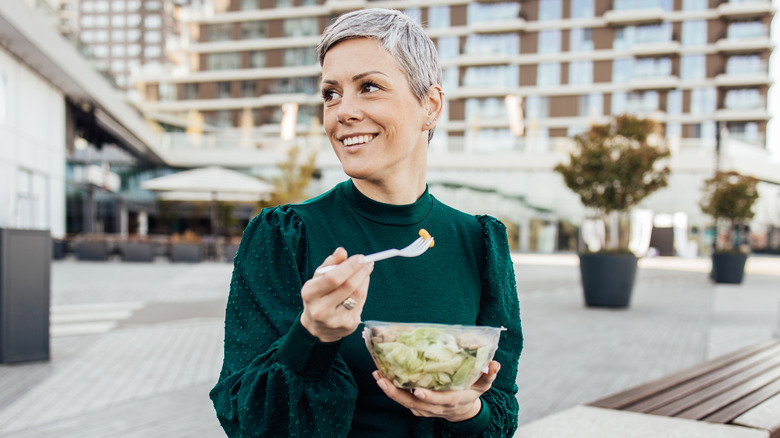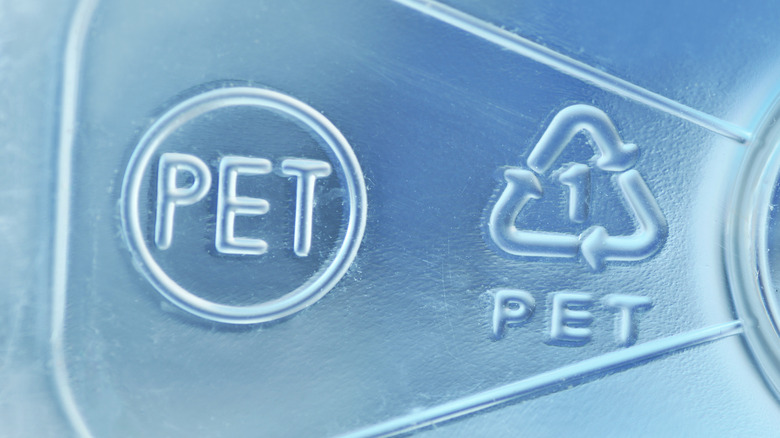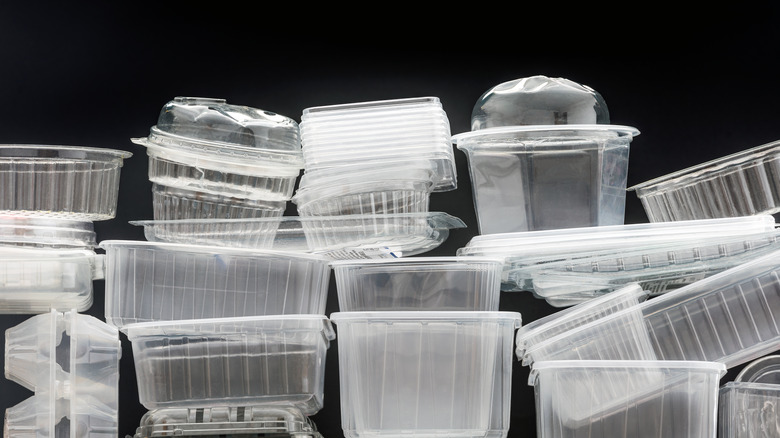Is It Safe To Reuse Plastic Takeout Containers For Food Storage? What We Know
No matter how environmentally conscious we try to be, we've all probably come back home with a plastic container full of leftover food from the restaurant we love. What about that time when you had takeout delivered to your doorstep? Did it come in plastic containers?
If you're like most people, you probably chuck the container in the fridge, take it out and have the leftovers the next day, and wash and save it somewhere in your home, not wanting to dump plastic in the garbage. Surely, you can reuse it, right? The answer might be a little more nuanced than you think. According to food scientist and founder of Wise Intake Dragomir Markovic, even regular plastic food containers have a shelf life of six months to a year (via Southern Living). The lifespan is even shorter with lower-quality plastic takeout containers that restaurants typically use.
"You can reuse them [but] it's hard to judge what's safe and what isn't," shared Genoa Warner, assistant professor in the department of Chemistry and Environmental Science at the New Jersey Institute of Technology (per Epicurious). The main concern with reusing plastic boxes is leaching. Leaching happens when plasticizers (additives that go into plastics that help with flexibility and durability of the product) seep out into the environment and food stored in the containers over time and use. These chemicals can mess with your hormones.
Looking at the back of the takeout container could give you some clues
Plastic storage cases (including restaurant takeout containers) have a triangle-shaped recycling symbol on the back with a number inside. The shape is meant to indicate recyclability, while the number refers to the type of resin used to make the plastic. The Smart Plastics Guide, which lists the numbers and their corresponding meanings, will also tell you about the different health risks associated with different types of plastic, as well as which ones can be used for food storage.
However, Michael Tunick, a research chemist in Drexel's Food and Hospitality Management department, told Southern Living that 1, 3, and 6 are actually single-use plastics, while 7 is made of polycarbonate — which leaches bisphenol A (BPA), a known endocrine-disrupting chemical (EDC) — and should not be reused.
Even with numbers and guides, there is much uncertainty with regard to the other additives that go into the making of plastic containers, shared Samara Geller, senior director of cleaning science at the Environmental Working Group (via Epicurious). "[The plastics industry] is really lacking transparency in terms of providing complete formulas for their plastic products, including their plastic take-out containers," explained Geller.
Is it possible, then, to safely reuse takeout containers? And if yes, how?
Store room-temperature dry food stuff in plastic takeout containers
Experts say it might be okay to reuse takeout containers from restaurants for a few months. Still, the best course of action is to avoid using them for storing food that's oily, hot, or acidic. While oily food might be difficult to clean off of plastic, acidic substances can contribute toward plastic degradation. If you want to be absolutely safe while reusing plastic, stick with dry, room-temperature food, advised Warner (via Epicurious). Also, if you don't feel safe using plastic containers to store food items, you can use them for puzzle storage, receipt organizing, and even storing your sewing supplies.
What you definitely shouldn't be doing, though, is throwing takeout plastic containers in the dishwasher or microwaving your food in plastic. Both of these will only increase the chances of leaching, which can harm your endocrine system. "Additionally, these containers will become more and more brittle over time, leading to a higher risk of microplastics flaking off and becoming ingested in your food," explained Bryan Quoc Le, a food scientist, food and beverage industry consultant, and author of "150 Food Science Questions Answered" (via Martha Stewart). Some obvious signs that a plastic container is no longer safe for use include discoloration, staining, scratched interiors, and texture changes. If you notice any of these, toss them in the garbage for recycling or find other (non-food storage) uses for them around the house.



